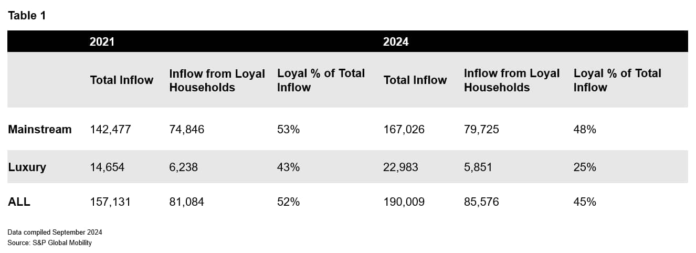In this first article of a three-part series, we examine
vehicle brand cannibalization with a focus on incremental gasoline
models. The next articles will explore hybrid models and electric
vehicles.
The debut of a new vehicle model often generates excitement as
automakers eagerly anticipate its market reception. Incremental
gasoline model launches play a crucial role in driving business for
brands, even as hybrid and electric vehicles rise in
popularity.
Incremental models are introduced into a brand's portfolio
without replacing an existing vehicle and they may even enter
segments where the brand already has other models.
However, a significant challenge with these launches is the risk
of cannibalization, where the majority of the new model's sales
come from existing customers rather than attracting buyers from
competitors. Understanding this dynamic is essential for brands
aiming to maximize the impact of their incremental offerings.
Product Cannibalization
Cannibalization occurs when a new model draws a significant
portion of its early buyers from within the brand. Loyal customers
eagerly upgrade, leaving the new model struggling to attract
conquest buyers. A 2021 analysis revealed that 52% of a new model's
early inflow came from households from the same brand. Although
this figure has decreased in 2024, it remains substantial.
For mainstream models examined in our 2024 study, 48% of the
total inflow in the first six months came from brand-loyal
households, while luxury models saw only 25% from within the same
brand. In the 6 to 12 months post-launch, these figures remained
stable: 47% for mainstream models and 25% for luxury models.
Adjacent Model Cannibalization
Another significant aspect of product cannibalization is the
impact on adjacent models within the brand's lineup. Incremental
models often take buyers away from similarly sized or priced
vehicles, creating an internal shift that may cannibalize sales of
existing models.
Table 2 highlights several incremental gasoline models launched
since 2020 and identifies the top inflow models (those from which
the new model draws most of its early buyers). The data shows that
adjacent models — those closest in size, price, or body style
— are often the most impacted.

For every incremental gasoline model listed, the highest level
of inflow came from existing vehicles within the same brand. For
example, 20% of the total inflow for the Toyota Grand Highlander
came from the Toyota Highlander, its closest sibling model.
Similarly, the Mazda CX-50 pulled 21% of its early inflow from the
CX-5, reflecting how closely linked these vehicles are in the
marketplace.
Looking Forward
Automakers must effectively balance retaining loyal customers
while attracting new buyers through incremental models. By
benchmarking the performance of their incremental models against
industry metrics, brands can assess whether their innovations are
successfully drawing in new customers. It is essential to analyze
how consumer preferences shift across gasoline, hybrid, and
electric vehicles, as this understanding will empower brands to
adapt their strategies. By leveraging these insights, automakers
can not only enhance their market position but also ensure they
remain competitive in an ever-evolving landscape.
Demo Our Loyalty Analytics
Tool.
Source link
